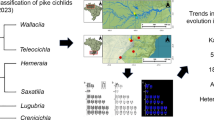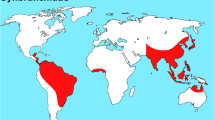Abstract
From an analysis of chromosomal mutations in seven species among five genera of marine triclads and polyclads, three different types of mechanisms of such mutations are identified: 1) rearrangement involving the centromere such that its position is changed, 2) rearrangement of whole chromosome arms, and 3) Robertsonian mechanisms. These mechanisms are the same as those reported for freshwater turbellarians, but aneuploidy and polyploidy, which are common in freshwater species, were not detected in these marine turbellarians.
Similar content being viewed by others
References
Ball, I.R., 1976. Les caryotypes de trois planaires marines nord-americaines: contribution à la phylogenie et la classification du groupe (Platyhelminthes, Turbellaria, Tricladida). Can. J. Zool. 54: 644–651.
Ball, I.R., 1979. The karyology of Procerodes lobata (Turbellaria, Tricladida, Maricola). Can. J. Zool. 57: 1820–1821.
Benazzi, M., 1982. Speciation events evidenced in Turbellaria. In C. Barigozzi (ed.), Mechanisms of speciation. Alan R. Liss, New York: 307–344.
Benazzi, M. & G. Benazzi Lentati, 1976. Plathyelminthes. In B. John (ed.), Animal Cytogenetics. Gebrüder Borntraeger, Berlin and Stuttgart, 182 pp.
Benazzi, M. & I. Puccinelli, 1973. A Robertsonian translocation in the freshwater triclad Dugesia lugubris: karyometric analysis and evolutionary inferences. Chromosoma 40: 193–198.
Galleni, L., R. Canovai, M. Gualandi, C. Pellicciari, S. Garagna & R. Stanyon, 1985. Fine characterization of turbellarian chromosomes I. Giemsa and Quinicrine banding in Dugesia polychroa (O. Schmidt). Genetica, in press.
Galleni, M., M. Nigro & I. Puccinelli, 1984. The chromosome complement of Procerodes dohrni (Tricladida: Maricola). J. mar. biol. Ass. U.K. 64: 227–231.
Galleni, L. & I. Puccinelli, 1975. Karyology of Notoplana igiliensis Galleni (Polycladida - Acotylea). Caryologia 28: 375–387.
Galleni, L. & I. Puccinelli, 1977. Karyometric analysis in Thysanozoon brocchii (Risso) (Turbellaria - Polycladida). Acc. Lincei Rend. Cl. Sci. fis., mat. nat. 63: 436–439.
Galleni, L. & I. Puccinelli, 1979. The karyology of the genus Procerodes (Tricladida: Maricola) in British waters. J. mar. biol. Ass. U.K. 59: 31–44.
Galleni, L. & I. Puccinelli, 1981. Karyological observation on polyclads. Hydrobiologia 84: 31–44.
Galleni, L. & I. Puccinelli, 1984. Karyology of five species of Turbellaria from the Øresund, Denmark. Ophelia 23: 141–148.
Galleni, L. & I. Puccinelli, 1985. Karyology of Yungia aurantiaca (Turbellaria: Polycladida). Trans. am. microsc. Soc. 104: 122–128.
White, M.J.D., 1978. Modes of speciation. W.H. Freeman & Company, San Francisco, 455 pp.
Author information
Authors and Affiliations
Rights and permissions
About this article
Cite this article
Galleni, L., Puccinelli, I. Chromosomal evolution in marine triclads and polyclads (Turbellaria). Hydrobiologia 132, 239–242 (1986). https://doi.org/10.1007/BF00046255
Issue Date:
DOI: https://doi.org/10.1007/BF00046255




